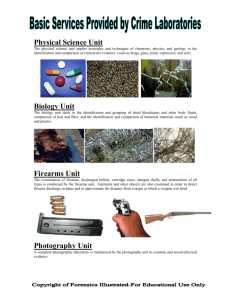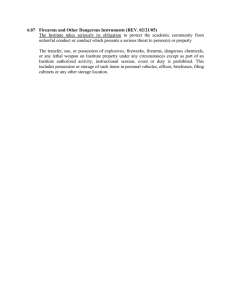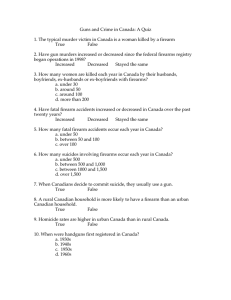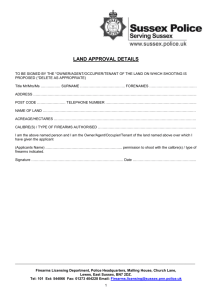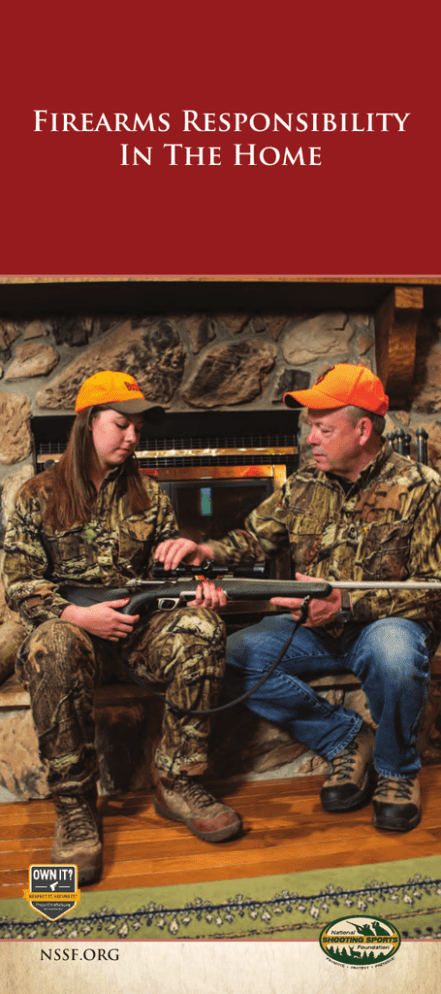
Firearms Responsibility
In The Home
NSSF.ORG
fact:
Accidents involving firearms in the
home have decreased significantly
over the last 20 years, according to
the National Safety Council.
By strictly following the
common-sense rules listed
in this brochure, parents and
children can prevent firearms
accidents in the home and
ensure that this downward
trend continues. All you have to
do is act responsibly and insist
that other members of your
family do the same.
Firearms
Responsibility
In The Home
As a firearms owner, you are
responsible for knowing how to
properly handle your firearms
and how to secure your firearms
in a safe manner in your home.
This brochure underscores the
responsibilities each and every one
of us must accept when we bring
firearms into our homes.
If for any reason you feel
uncomfortable with or are
unable to accept these
responsibilities, we strongly
urge you not to own a firearm.
RULES FOR
SAFE STORAGE
OF FIREARMS
Always unload
sporting firearms
carefully and
completely before
taking them into the
home, remembering
to keep the muzzle
pointed in a safe direction. Never load a
sporting firearm in the home.
Always make absolutely
sure that firearms in
your home are securely
stored out of the reach
of children and other
unauthorized persons.
Unloaded firearms
can be secured with
a firearm locking
device to make them
inoperable. Unloaded
firearms also can be
stored in a locked
cabinet, safe, firearm
vault or storage case.
Always store ammunition in
a locked location separate
from firearms and out of
the reach of children.
Always clean
and place
firearms in
their proper
storage location
immediately
after returning
from a hunting
trip or a day at
the range.
Always re-check
firearms carefully
and completely to
be sure that they
are still unloaded
when you remove
them from storage.
Accidents have occurred when a family
member has borrowed or loaned a firearm
and returned it to storage while it was still
loaded.
remember:
You are responsible for making certain
the firearms in your home are not casually
accessible to anyone — especially curious
young people.
FIREARMS ACCIDENTS IN THE HOME can
be prevented simply by making
sure that firearms are kept
unloaded and safely stored,
with ammunition secured
in a separate location.
SAFE AND SECURE
STORAGE OPTIONS
More than 40 million Americans
enjoy using rifles, shotguns and handguns
for hunting and target shooting. When
these firearms are not being used, they
must be safely and securely stored. This is
where firearms responsibility in the home
begins — and ends.
Options to help you safely store your
firearms include:
FIREARM CASE
CABLE LOCK
ELECTRONIC LOCK BOX
LOCK BOX
importan
t
:
ALWAYS
make absolutely
sure that firearms
in your home are
securely stored
and inaccessible to
children.
A firearm locking device is intended
only to deter access to a firearm by
unauthorized persons, particularly
children. A firearm
locking device is
not intended to
withstand forced
entry by someone
determined to
defeat the lock by
using tools or other
aggressive means.
A firearm locking device should be
considered as only one element of a
safe storage program for firearms.
Securely storing firearms when
not in use is the
FIREARM SAFE
1
no.
way to help prevent
accidents.
Check municipal, county, state and federal
law for any requirements about safe storage
of firearms and ammunition, as well as
requirements about having loaded firearms
and the discharge of firearms in your
community.
FIREARMS KEPT FOR HOME
SECURITY
The decision to maintain a firearm
in the home for self-protection is a serious,
personal matter. Any added safety benefit
gained from owning a firearm depends
in large measure on the owner’s having
appropriate training and clear understanding
of safe handling and storage rules. Factors
such as individual temperament, reaction
to emergency situations, specific family
circumstances and support for your having a
firearm in the home from other adults in the
household must be considered.
If you feel the need for quick access to a
loaded firearm in your home, you must take
special safety measures. Keeping a firearm
to defend your family makes no sense if
that same firearm puts family members or
visitors to your home at risk.
In keeping a firearm for home security, your
objective should be to have the firearm
readily available to you, yet not accessible
to others. Special lockable cases that can
responsible:
Your most important responsibility is
ensuring that children cannot encounter
loaded firearms. The precautions you take
must be effective. Anything less invites
tragedy and is a serious violation of your
responsibility as a firearm owner.
Your home will be as safe
as you choose to make it.
be quickly opened by authorized individuals
are options to consider.
You must exercise full control and
supervision over a loaded firearm at all
times. This means the firearm must be
unloaded and placed in secure storage
whenever you leave your home. Secure
ammunition separately.
Fatal home
firearms accidents
can occur when
children discover
firearms that
adults thought
were safely hidden
or out of reach.
Firearms owners who live with a
person who is at-risk or legally prohibited from
possessing a firearm may wish to consider
upgrading their storage levels to better meet
their safe-storage responsibilities. You must
be absolutely certain that no firearm can be
accessed by an at-risk or prohibited person.
Simply hiding a firearm is not secure storage
and poses a risk.
Persons considered to be at-risk may include
those with symptoms or history of treatment for
mental illness, increasing patterns of alcohol/
substance abuse, isolation or violent behaviors,
or recent experience with a major life event—
such as divorce, job loss or financial trouble.
It also can be someone who you, the firearms
owner, have good reason to believe is likely to
do harm to themselves or others.
A person is legally prohibited from
possessing a firearm if he or she is a
convicted felon, fugitive from justice, unlawful
user of any controlled substance, illegal alien,
dishonorably discharged from the military,
subject to a court restraining order, has been
convicted of a crime involving domestic
violence, has renounced U.S. citizenship, or
who has been deemed mentally incompetent
(“a mental defective”) by a court or
involuntarily hospitalized for psychiatric care.
In this situation, consider storing firearms
not in use in a locked gun safe or other
appropriate security device that is resistant
to tampering by an adult. If for any reason
you as a firearms owner feel uncomfortable
with or are unable to accept these safestorage responsibilities given the circumstance
of having an at-risk or
prohibited person living
with you, we strongly urge
you not to own a firearm.
NS
DETERRING ACCESS BY
AT-RISK AND PERSO
PROHIBITED
Temporary off-site storage is an option. Such
storage can be effective, for example, if an
individual living with you is in emotional crisis
or exhibits significant behavior change. Friends
who are gun owners might offer storage. Your
local firearms retailer may know of options for
off-site firearms storage in your area.
Secure storage options for gun owners living
with at-risk or prohibited persons include a
locked gun safe, gun cabinet, lock box or
storage case. For added security, portable
storage devices can be secured to a wall
or the floor, or both, to prevent removal.
In addition to locked storage, unloaded
firearms can be secured with a gun-locking
device that renders the firearm inoperable.
Firearms can also be disassembled, with parts
securely stored in separate locations. Please
review fully the sections in this booklet titled
“Storing Firearms in a Safe Manner” and
“Options for Securely Storing Firearms.”
Learn more about at-risk behavior and find
resources at the National Institute of Mental
Health website: nimh.nih.gov. As a family
member or friend, you may be in a position
to encourage a person in distress to seek
assistance from a qualified provider.
Learn more about persons who are legally
prohibited from possessing firearms at the
Bureau of Alcohol, Tobacco, Firearms and
Explosives website: atf.gov/firearms/how-to/
identify-prohibited-persons.html.
SAFE
HOME
CHECKLIST
kept for security reasons are
3 Firearms
fully controlled at all times.
3
Firearms are securely stored in a
location inaccessible to children and
other unauthorized persons.
SAFETY TIPS
GENERAL FIREARM
HANDLING
Treat every firearm as if it were
loaded.
Keep the muzzle pointed in a
safe direction.
Keep your fingers off the trigger.
Don’t rely on your firearm’s
“safety” device.
3
Sporting firearms are unloaded before
they are brought into the home and
never loaded while in the home.
3
Sporting firearms are immediately
cleaned and placed in secure storage
when they are returned from hunting or
target shooting.
3
When firearms are removed from
storage, they are always carefully
checked to confirm that they are
unloaded.
household must understand and
follow the requirements of
Firearms Responsibility
In The Home.
is stored under lock and
3 Ammunition
key, separately from firearms.
NOTE TO PARENTS:
Read with your children and have
them sign the attached special
Kids Message and Contract.
owner’s manual that came with the
3 The
firearm must be read and understood.
Keep the firearm unloaded when
not in use.
All members of the
For more information about firearms
ownership and storage visit:
projectchildsafe.org
FOR
Kids
There is one important step you can take
right now to prove you are responsible
about firearms. Sign this Firearms
Responsibility Contract and give it to
your parents.
FIREARMS RESPONSIBILITY
CONTRACT
I Hereby Promise:
• I will not handle guns without
permission from a grown-up that I
know.
• I will never play with guns.
• I will not go snooping or allow my
friends to go snooping for guns in the
house.
• If I find a gun, even if it looks like
a toy, I will not touch it; I will tell a
grown-up I know right away.
• I will obey the rules of safe gun
handling.
Signed_____________________________
Date________________________________
A message
to kids
about
Firearms
Responsibility
Not long ago, in another town, some kids
found a firearm. Maybe they were looking for it
because of something they saw on television.
Maybe one of them dared the other to find it.
Maybe they just found a firearm that was left out
by mistake. It doesn’t matter why they found it.
What matters is the firearm was loaded, and they
played with it. Now they are very sorry they did.
Don’t let this happen to you. Always follow these
safety rules:
• Don’t go looking for firearms, in your
house or a friend’s house. Don’t let
other kids look for firearms in your
house.
• If you find a firearm in your house —
or anywhere else — leave it alone.
Don’t touch it! Don’t let anyone else
touch it! Tell an adult.
• Even if a firearm looks like a toy —
don’t touch it! Some real firearms look
like toys. Don’t take a chance. Tell an
adult.
Remember...if you find a
firearm, don’t pick it up.
Just leave it alone and
tell an adult right away.
11 Mile Hill Road
Newtown, CT 06470-2359
T: 203.426.1320
F: 203.426.1087
nssf.org
©2014 National Shooting Sports Foundation, Inc. All Rights Reserved. This brochure may be reproduced for legitimate
educational purposes provided 1.) the pamphlet is reprinted in its entirety, including this paragraph, and 2.) no fee is charged.
RTO 550M 6/14 Item #80
Promote
Protect
Preserve

